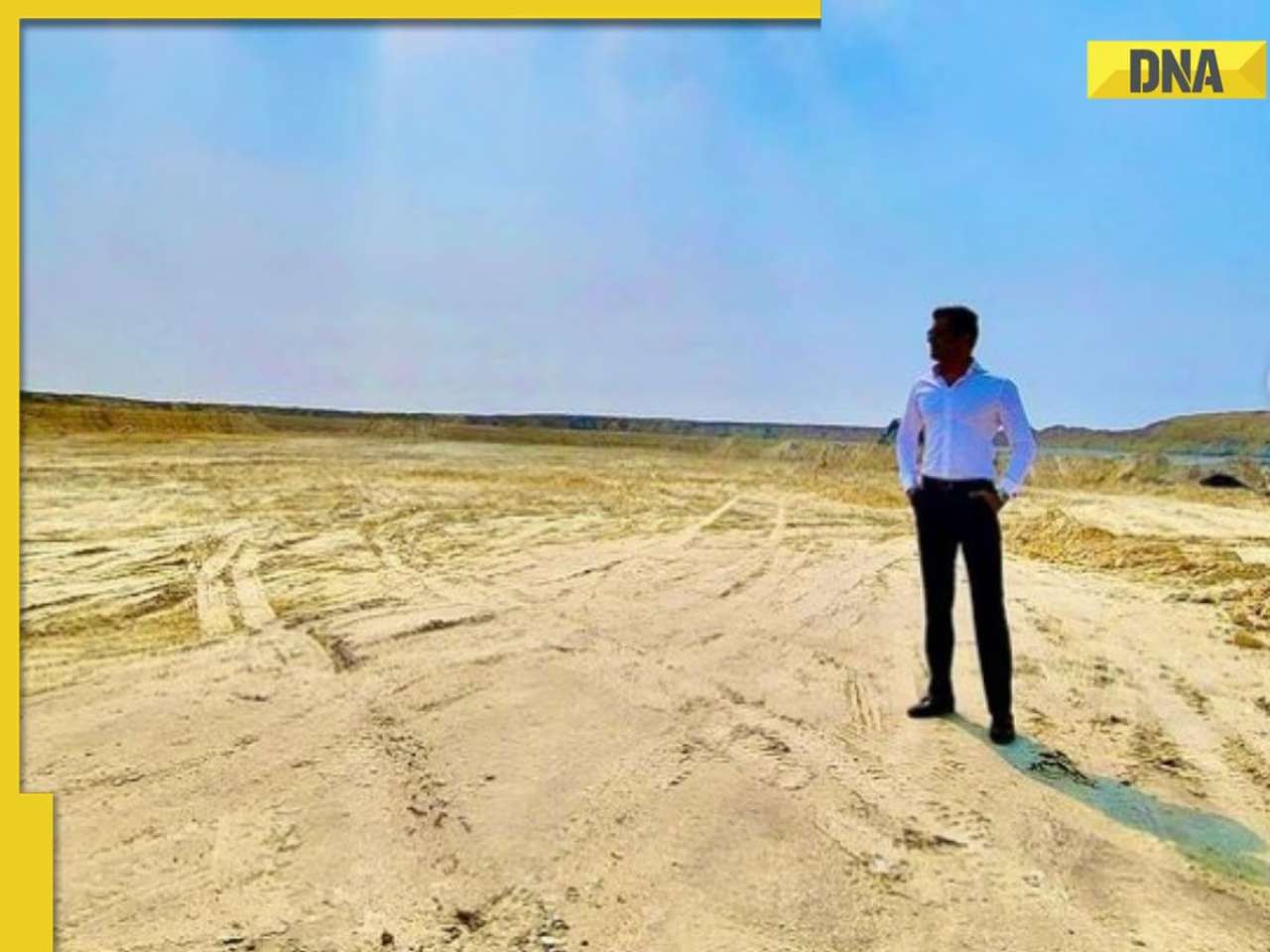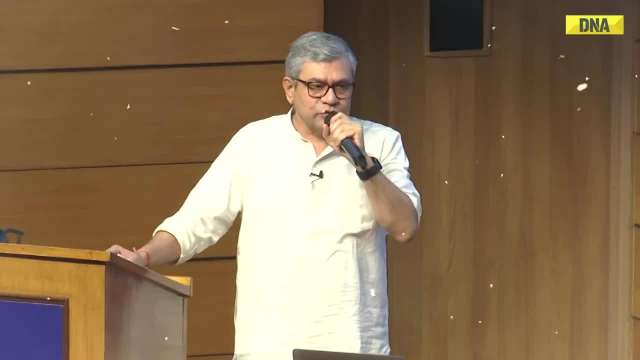In a total lunar eclipse, the Moon is completely enveloped by the umbra, the darkest portion of Earth's shadow.
When the Total Lunar Eclipse occurs, it will cause the moon to become a blood red, providing a once-in-a-lifetime sight for amateur astronomers everywhere. When the Sun, Earth, and Moon are in a straight line, the Moon experiences a lunar eclipse as it moves through Earth's shadow.
According to NASA,"Light travels in waves, and different colours of light have different physical properties. Blue light has a shorter wavelength and is scattered more easily by particles in Earth’s atmosphere than red light, which has a longer wavelength."
At the time of a total lunar eclipse, the Moon is completely enveloped by the umbra, the darkest section of Earth's shadow. Because of its proximity to Umbra, the moon takes on a distinctive blood red coloration while in this region. Nasa said the same thing that makes our skies blue and sunsets red also causes the Moon's colour to shift.
A lunar eclipse causes the Moon to seem red because Earth's atmosphere blocks any direct sunlight from reaching the Moon. The redder the Moon appears during an eclipse is due to the amount of dust or clouds in Earth's atmosphere.
A Total Lunar Eclipse doesn't happen again until 2025, making the one on November 8 all the more special. On March 14, 2025, we will see another complete lunar eclipse. However, partial lunar eclipses will persist for years to come.
Also, READ: ISRO plans to send rover to Moon's dark side in collaboration with Japan's JAXA
The Sun, Earth, and Moon need to be nearly in a line at the exact right moment and day for a lunar eclipse to take place. An eclipse cannot occur until the Earth's shadow falls on the Moon. A complete lunar eclipse occurs when the Sun, Earth, and Moon form a straight line.
Umbra refers to the centre, darkest section of the eclipse's shadow on Earth; Penumbra describes the outer, partially shaded component of the shadow; and Antumbra refers to the partially shaded region beyond the umbra. A complete lunar eclipse may only occur when the moon is full and also a lunar node, meaning the Sun, Moon, and Earth are in a straight line.
![submenu-img]() Meta CEO Mark Zuckerberg spotted wearing watch made from…; it costs over Rs…
Meta CEO Mark Zuckerberg spotted wearing watch made from…; it costs over Rs…![submenu-img]() Indian women's chess team wins historic gold at Chess Olympiad 2024
Indian women's chess team wins historic gold at Chess Olympiad 2024![submenu-img]() Meet cricketer-turned-entrepreneur who built Rs 100 crore company backed by Malaika Arora, Shahid Kapoor, Jennifer Lopez
Meet cricketer-turned-entrepreneur who built Rs 100 crore company backed by Malaika Arora, Shahid Kapoor, Jennifer Lopez![submenu-img]() Vir Das invites budding designers to create his outfit as International Emmy Awards host: 'Not going to wear a...'
Vir Das invites budding designers to create his outfit as International Emmy Awards host: 'Not going to wear a...'![submenu-img]() Who is Anura Kumara Dissanayake, new President of Sri Lanka? All you need to know
Who is Anura Kumara Dissanayake, new President of Sri Lanka? All you need to know![submenu-img]() Sri Lanka Elections: श्रीलंका के नए राष्ट्रपति होंगे अनुरा दिसानायके, मजदूर का बेटा बना राष्ट्रपति
Sri Lanka Elections: श्रीलंका के नए राष्ट्रपति होंगे अनुरा दिसानायके, मजदूर का बेटा बना राष्ट्रपति![submenu-img]() MP में सेना की स्पेशल ट्रेन उड़ाने की साजिश के पीछे किसका हाथ?, जांच में जुटी NIA, धमाके की आवाज सुन लगाया ब्रेक
MP में सेना की स्पेशल ट्रेन उड़ाने की साजिश के पीछे किसका हाथ?, जांच में जुटी NIA, धमाके की आवाज सुन लगाया ब्रेक![submenu-img]() Bengal Floods: सीएम ममता बनर्जी ने DVC से पानी छोड़ने पर लिखा PM को पत्र, सीनियर अधिकारियों का इस्तीफा
Bengal Floods: सीएम ममता बनर्जी ने DVC से पानी छोड़ने पर लिखा PM को पत्र, सीनियर अधिकारियों का इस्तीफा![submenu-img]() Sridevi की बेटी बन बॉलीवुड में बनाई पहचान, अब Prabhas की इस फिल्म से हिंदी सिनेमा में करेंगी वापसी
Sridevi की बेटी बन बॉलीवुड में बनाई पहचान, अब Prabhas की इस फिल्म से हिंदी सिनेमा में करेंगी वापसी![submenu-img]() चोरी से भारत में घुसे 11 बांग्लादेशी गिरफ्तार, चेन्नई-अहमदाबाद जाने की थी तैयारी, GRP के सामने उगले राज
चोरी से भारत में घुसे 11 बांग्लादेशी गिरफ्तार, चेन्नई-अहमदाबाद जाने की थी तैयारी, GRP के सामने उगले राज![submenu-img]() Ford to return to India after 2 years with reopening of....
Ford to return to India after 2 years with reopening of....![submenu-img]() Maruti Suzuki launches new Swift CNG, check price, mileage, other features
Maruti Suzuki launches new Swift CNG, check price, mileage, other features![submenu-img]() ‘30 LPA, 3BHK, no in-laws’: Woman earning Rs 1.32 lakh salary lists demands for future husband, netizens say...
‘30 LPA, 3BHK, no in-laws’: Woman earning Rs 1.32 lakh salary lists demands for future husband, netizens say...![submenu-img]() In a big EV push, Centre launches Rs 10900 crore PM E-Drive scheme to replace…
In a big EV push, Centre launches Rs 10900 crore PM E-Drive scheme to replace…![submenu-img]() World’s longest car has helipad, swimming pool, mini-golf course, can seat over…; it cost…
World’s longest car has helipad, swimming pool, mini-golf course, can seat over…; it cost…![submenu-img]() IAS officer Tina Dabi’s schedule shows she studied 11-hour a day; check UPSC topper's marksheet and time table
IAS officer Tina Dabi’s schedule shows she studied 11-hour a day; check UPSC topper's marksheet and time table![submenu-img]() Meet man from Uttar Pradesh who cracked UPSC in first attempt, resigned as IAS officer after 12 years due to...
Meet man from Uttar Pradesh who cracked UPSC in first attempt, resigned as IAS officer after 12 years due to...![submenu-img]() Meet man who once worked as bicycle mechanic, became engineer, then cracked UPSC exam with AIR...
Meet man who once worked as bicycle mechanic, became engineer, then cracked UPSC exam with AIR...![submenu-img]() CBSE registration, LoC submission big update: Important notice for students, check details here...
CBSE registration, LoC submission big update: Important notice for students, check details here...![submenu-img]() CBSE registration, LoC submission big update: Important notice for students, check details here
CBSE registration, LoC submission big update: Important notice for students, check details here![submenu-img]() Congress President Kharge Slams & Opposes 'One Nation, One Election' Proposal, Calls It Impractical
Congress President Kharge Slams & Opposes 'One Nation, One Election' Proposal, Calls It Impractical![submenu-img]() Why 'One Nation One Election' Is important? Ashwini Vaishnaw Explains After It Gets Cabinet Approval
Why 'One Nation One Election' Is important? Ashwini Vaishnaw Explains After It Gets Cabinet Approval![submenu-img]() Jammu Kashmir Assembly Election 2024 Phase 1 Highlights: What Happened In First phase In J&K Polls?
Jammu Kashmir Assembly Election 2024 Phase 1 Highlights: What Happened In First phase In J&K Polls?![submenu-img]() One Nation One Election: Centre Clears Proposal, Bill To Be Introduced In Winter Session | Modi 3.0
One Nation One Election: Centre Clears Proposal, Bill To Be Introduced In Winter Session | Modi 3.0![submenu-img]() Haryana Elections 2024: Is BJP Set To Lose In Haryana? Anti-Incumbency And Other Factors Analysed
Haryana Elections 2024: Is BJP Set To Lose In Haryana? Anti-Incumbency And Other Factors Analysed![submenu-img]() Inside pics of Anant Ambani and Radhika Merchant's Dubai villa gifted by Mukesh Ambani and Nita Ambani, worth Rs…
Inside pics of Anant Ambani and Radhika Merchant's Dubai villa gifted by Mukesh Ambani and Nita Ambani, worth Rs…![submenu-img]() Anupam Mittal’s Playbook: The Secrets Behind Building Iconic Brands
Anupam Mittal’s Playbook: The Secrets Behind Building Iconic Brands![submenu-img]() Meet woman, who came to India as tourist, established Rs 49000 crore firm, know her connection with Ratan Tata
Meet woman, who came to India as tourist, established Rs 49000 crore firm, know her connection with Ratan Tata![submenu-img]() Meet Delhi man, whose street food made him 'crorepati', rides BMW to work, his business is...
Meet Delhi man, whose street food made him 'crorepati', rides BMW to work, his business is...![submenu-img]() Meet man, one of Surat's richest, whose son worked at bakery for Rs 200 a day, gift flats to employees, net worth is...
Meet man, one of Surat's richest, whose son worked at bakery for Rs 200 a day, gift flats to employees, net worth is...![submenu-img]() 8 amazing images of distant galaxies by NASA's Hubble Space Telescope
8 amazing images of distant galaxies by NASA's Hubble Space Telescope![submenu-img]() Most luxurious train rides in the world
Most luxurious train rides in the world ![submenu-img]() This star was called ugly child, filed case against mother, slapped Sanjeev Kumar; her husband was burnt alive at...
This star was called ugly child, filed case against mother, slapped Sanjeev Kumar; her husband was burnt alive at...![submenu-img]() 7 foods that can add extra years to your life
7 foods that can add extra years to your life![submenu-img]() In pics: Triptii Dimri sets the stage on fire, raises the temperature in green slit lehenga
In pics: Triptii Dimri sets the stage on fire, raises the temperature in green slit lehenga![submenu-img]() Bystander Intervention: Powerful Tool for Combating Gender-Based Violence AsWellAs Saving Victims of Road Accidents
Bystander Intervention: Powerful Tool for Combating Gender-Based Violence AsWellAs Saving Victims of Road Accidents ![submenu-img]() Uday Bhanu Chib appointed Indian Youth Congress Chief, succeeds Srinivas BV
Uday Bhanu Chib appointed Indian Youth Congress Chief, succeeds Srinivas BV![submenu-img]() Mamata Banerjee writes second letter to PM Modi on devastating 'man-made' flood in South Bengal
Mamata Banerjee writes second letter to PM Modi on devastating 'man-made' flood in South Bengal![submenu-img]() Arighat's Rise: India's Nuclear Might in a Godless World
Arighat's Rise: India's Nuclear Might in a Godless World![submenu-img]() PIL in Supreme Court seeks SIT probe into Tirupati laddu row
PIL in Supreme Court seeks SIT probe into Tirupati laddu row













































)
)
)
)
)
)
)
)
)
)
)
)
)
)
)





)
)
)
)
)
)